Embarking on the journey of selecting the right bird feeder can be as exhilarating as observing the flutter and chatter of backyard birds. To assist you in navigating this delightful endeavor, we’ve compiled an authoritative bird feeder buying guide. Delve into our backyard bird feeder tips to understand the nuances of bird feeder designs and their respective attractions. Whether you’re a seasoned birder or new to the avian world, we will guide you through best bird feeder features to transform your outdoor space into a birdwatching haven.
With an array of options, pinpointing how to choose the best bird feeder for your backyard requires strategic thinking. Aspects such as durability, the ease of maintenance, seed protection, and adaptability to various bird species are the building blocks for the ideal bird-watching experience. Our insights ensure you make an informed decision, balancing the ecological needs with your personal touch.
Understanding Bird Feeder Types: A Comprehensive Guide
Attracting backyard birds begins with choosing the right type of bird feeder for your garden. From the basic tray feeder to the specific nyjer feeder, each style has its own set of features designed to cater to various bird species and their feeding habits. Let’s dive into the details of each feeder to help you find the perfect match for your birdwatching aspirations.
Tray or Platform Feeders Explained
Tray or platform feeders are the most accessible types of bird feeders for a diverse group of birds. Their open design invites a wide array of seed-eating feathery guests but also demands regular maintenance. The finest platform feeders have an emphasis on drainage to prevent soggy seeds and disease spread, with screens or holes that promote quick drying. To reduce visits from unintended wildlife, position tray feeders strategically and keep the seed offerings minimal, replenishing only as needed to maintain freshness.
The Lowdown on Hopper or “House” Feeders
Hopper feeders, resembling cute houses, are not only charming additions to any garden but also practical solutions for keeping seeds dry and clean. Although these feeders protect against precipitation and waste, vigilance in preventing moisture buildup is vital. For hopper feeder owners, routine inspection and cleaning to keep mold and bacteria at bay is as necessary as it is for the birds’ health.
Evaluating Window Feeders for Intimate Bird Watching
The appeal of window feeders lies in the pleasure of observing birds from a close vantage point, right at your windowpane. While they bring the beauty of nature up close, they also pose a high-maintenance scenario. Daily replenishment of seeds is recommended for window feeders, as is regular cleaning to ensure the health and safety of your feathered visitors.
Advantages of Tube Feeders for Small Birds
Tube feeders are specifically advantageous for feeding small birds such as finches and chickadees. Their design often includes features that can deter squirrels and are optimal for keeping seeds dry. However, attention must be given to the bottom of the feeder, ensuring it does not become a collecting point for dated seeds which may lead to mold, impacting the tube feeder’s efficacy and safety.
Nyjer Feeders: A Favorite of Finches
Nyjer feeders, distinguished by their slender tube design or mesh bags, are a delight for finches including the charming American Goldfinch. Their small feeding ports are perfect for dispensing the tiny nyjer seeds these birds adore. While relatively low-maintenance, they should be monitored for seed freshness and protection from the elements.
Suet Feeders for Woodpeckers and Other Clingers
For those interested in attracting woodpeckers, nuthatches, and other clinging birds, suet feeders are the feeder of choice. Some designs encourage birds to hang upside down, reducing access for less agile species like starlings. The variety of suet feeder designs, including coated wire mesh options, ensures that concerns about safety are addressed while providing a high-energy food source.
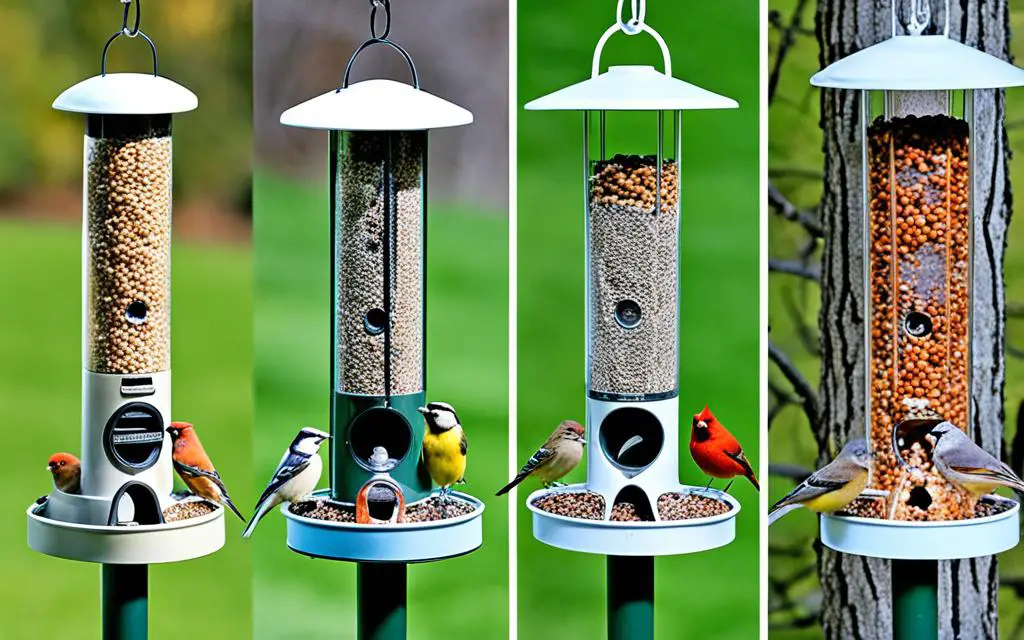
When selecting from the different types of bird feeders, it’s important to consider the specific bird species you are aiming to attract to your backyard and the particular needs associated with each feeder type.
Essential Factors to Consider When Selecting a Bird Feeder
When you’re immersed in the world of bird watching and wish to elevate your experience, proper bird feeder selection help can make all the difference. Top bird feeder criteria not only enhance your own enjoyment but also ensure the health and safety of your feathered visitors. Considering the diversity of avian species and their unique feeding preferences, selecting the best bird feeder features becomes crucial. This guide illuminates the key factors every birding enthusiast should weigh before making a purchase.
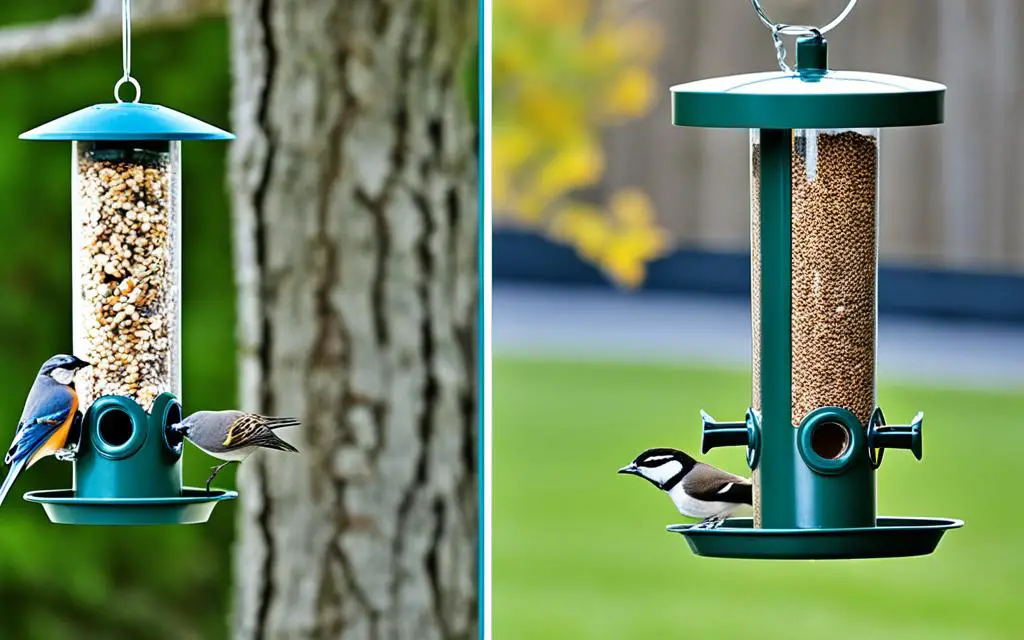
Durability: A superior bird feeder must stand the test of time and weather. It should be robust enough to brave the elements, from the scorching summer sun to the biting chill of winter.
Design & Accessibility: Bird feeding habits vary significantly across species. Some may prefer the easy access of tray feeders, while others might lean towards the protected confines of tube feeders. The design should also offer ease of access for filling and cleaning without compromising security from natural foragers like squirrels.
Maintenance: Feeders should promote excellent hygiene with features that prevent mold and bacteria growth. Consequently, designs that are easy to disassemble and clean are non-negotiable for the conscientious bird watcher.
Seed Protection: Your bird feeder should be adept at keeping the seeds dry and fresh. Enclosed feeders can ward off rain and snow, while mesh designs might necessitate more frequent attention.
Pest Deterrence: One of the most persistent challenges in bird feeding is the presence of eager squirrels. Bird feeders with specialized mechanisms, such as weight-sensitive perches or sturdy materials, can keep these clever creatures at bay.
Environmental Compatibility: The location and context of where the feeder will hang also determine the appropriate feeder choice. A feeder should complement its surroundings and provide a safe spot for birds to dine away from potential threats.
| Feature | Description | Benefits |
|---|---|---|
| Material | High-quality plastics, metals, or woods | Durability, longevity, and resilience against weather or pests |
| Design | Varied to suit different species | Allures a variety of birds and satisfies different feeding habits |
| Maintenance Access | Removable parts, simple assembly | Promotes clean feeding environment, easy to refill and clean |
| Seed Protection | Rain guards, drainage systems | Keeps seeds dry, preventing spoilage and potential diseases |
| Pest Deterrence | Weight-sensitive closures, metal perches | Prevents squirrels and other pests from depleting bird food supplies |
| Environmental Fit | Feeder size, placement compatibility | Ensures feeder aligns with the backyard’s aesthetic and safety |
Armed with these insights into bird feeder selection help, you’re now primed to make a choice that harmonizes with your passion for bird feeding and watching. By factoring in these criteria, you’ll enrich your avian sanctuary and indulge in the serene pleasures of bird watch
How to Attract Your Favorite Birds: Seed Selection Strategies
Choosing the right seeds for your bird feeders is crucial in attracting a variety of birds to your backyard. Understanding the preferences of regional birds and selecting the appropriate mix can drastically enhance your bird watching experience. Ergo, it is important to consider different seed types, such as nyjer seed, thistle seed, mixed seed, and black oil sunflower seeds, and how they cater to different species. With a little knowledge and the right seeds, your garden can become a vibrant haven for the colorful winged visitors you desire.
Delight Finches with Nyjer Seed
Affectionately known as the “finch magnet,” nyjer seed is an oil-rich, calorific treat that is irresistible to various finch species, including the American Goldfinch and Pine Siskin. To optimize this attraction, choosing bird feeders tailored for these slender seeds, such as nyjer feeders that offer very small feeding ports, will prevent waste and cater specifically to the feeding mechanics of finches.
Attract a Variety with Mixed Seed
Mixed seeds serve as an all-inclusive blend, catering to birds with a range of preferences and feeding behaviors. A well-formulated mixed seed blend can attract a plethora of birds like sparrows, blackbirds, doves, and more. To efficiently offer mixed seed, consider utilizing a versatile hopper or tray feeder, which can conveniently accommodate this variety and make it accessible to a wider circle of backyard birds.
Lure Larger Birds with Black Oil Sunflower Seeds
As a high-energy feed, black oil sunflower seeds are a favorite among avian communities due to their meatier content and thinner shells, making them easier to crack open. Their versatility makes them the centerpiece of any seed offering, drawing in a diversity of birds from finches to cardinals and chickadees. For optimal dispensing, robust hopper or tube feeders are excellent choices for keeping the sunflower seeds fresh and readily available to the larger bird species.
Catering to Smaller Species with Safflower and Thistle Seed
Safflower and thistle seeds (also referred to as thistle seed when pertaining to bird food) are smaller and appeal to species that may be intimidated by larger seeds or more crowded feeders. By being selective with feeders that have specialized ports for these smaller seeds, backyard bird watchers can allure more timid species, ensuring these little guests also have a chance to dine in peace.
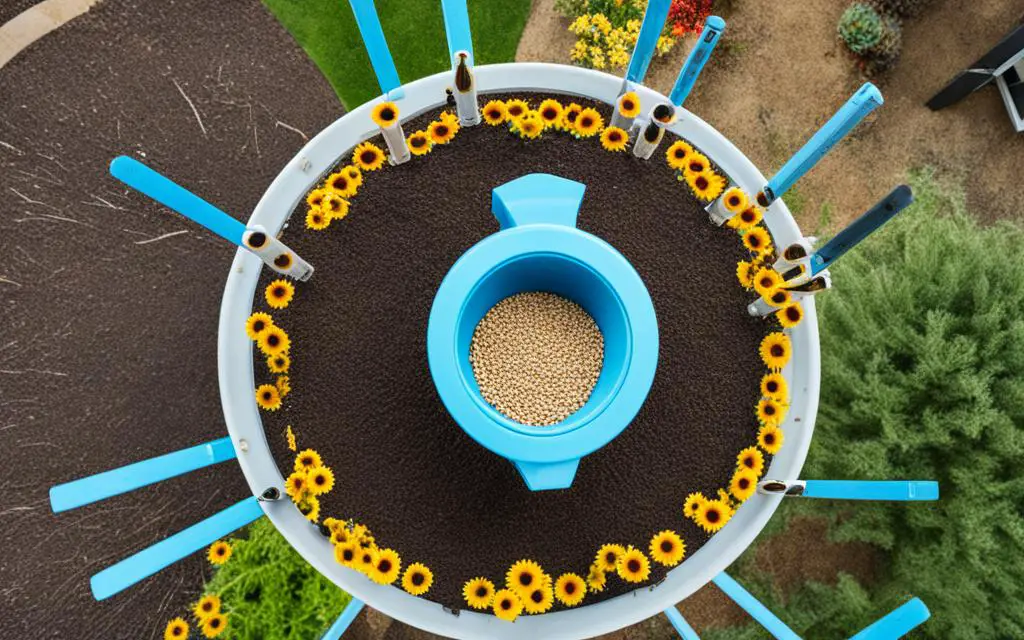
In sum, when choosing bird feeders for backyard birds, the seed selection plays an indispensable role. Not only does it determine which species you will attract, but it also affects the frequency of their visits. Be mindful of the birds endemic to your region and select a combination of seeds that will encourage a diverse and delightful bird population to grace your garden.
Location, Location, Location: Where to Place Your Bird Feeder
Finding the best places to put bird feeders is pivotal in creating a backyard oasis that is safe and engaging for birds and birdwatchers alike. The interplay between feeder placement and attracting birds to your feeder cannot be overstated. The ideal location is not just about visibility or aesthetics; it’s about combining practicalities with the natural instincts of your feathered guests.
A well-considered bird feeder pole or bird feeder stand can make all the difference in accessibility, offering a quick refill or cleaning operation that should be performed regularly. Strategic placement also plays a crucial role in protecting vulnerable birds from domestic threats, such as cats, and naturally occurring dangers like hawks.
Below is a table summarizing key factors to consider when choosing a location for your bird feeder. It provides a guide designed to optimize bird safety, viewing pleasure, and practical maintenance.
| Location Factor | Considerations | Benefits |
|---|---|---|
| Distance from Windows | Safe distance that reduces reflection and prevents collisions | Increases bird safety and prevents injury or death from window strikes |
| Height from Ground | Higher than 5 feet to discourage predators | Keeps birds away from cats and other ground predators |
| Proximity to Shelter | Near enough to trees or shrubs for emergency retreats | Gives birds a sense of security and quick escape routes from predators |
| Visibility to Birders | Clearly visible from a home window or seating area | Enhances the birdwatching experience without disturbing the birds |
| Accessibility for Maintenance | Easy to reach for regular refills and cleaning | Ensures a healthy feeding environment for birds |
| Natural Feeding Environment | Surroundings that mimic natural foraging areas | Encourages natural bird behavior and promotes a diverse ecosystem |
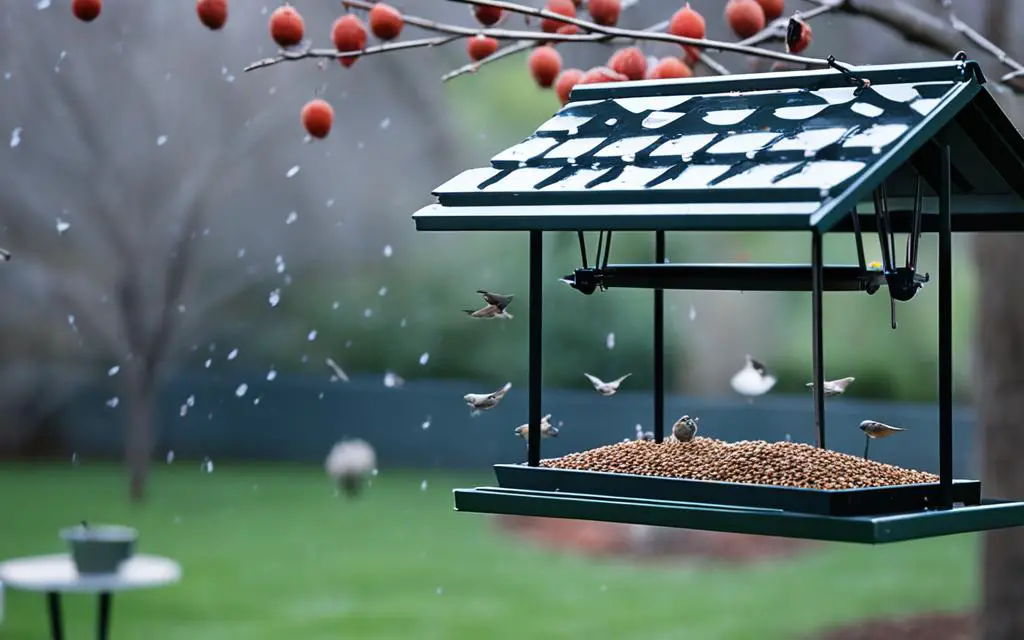
In conclusion, choosing the right spot for your feeder involves balancing factors that impact both the birds and the humans who enjoy watching them. Whether it’s selecting the ideal bird feeder stand for cardinals or determining the safest bird feeder pole placement to thwart squirrels, your goal is to create a harmonious environment. Through thoughtful feeder positioning, you not only contribute to the well-being of local bird populations but also enhance the beauty and vitality of your own outdoor space.
Weatherproof and Pest-Resistant: Choosing Durable Bird Feeders
For bird enthusiasts, it’s essential to invest in bird feeders that can stand up to the challenges of outdoor conditions. This means searching for options that can endure the unpredictable climate and the persistent efforts of local wildlife. Weatherproof bird feeders not only extend the life of your bird feeder but also ensure the safety and well-being of your feathered friends. These resilient feeders come equipped with materials and designs aimed at keeping seeds fresh and dry while deterring savvy pests like squirrels.
Features of Squirrel-Resistant Feeders
Squirrel resistant bird feeders are key to keeping birds safe from predators and ensuring that the nourishing seeds are available exclusively for birds. Constructed with durable materials and mechanisms, such as weight-sensitive perches or exclusionary bars, these feeders protect your seed supply from being raided. Robust metal feeders can also resist the gnawing of squirrels, which safeguards not just the food, but the structural integrity of the feeder itself.
Benefits of Choosing a Rust-Resistant Model
Selecting a rust resistant bird feeder provides long-term benefits that far outweigh the initial investment. These models are typically made from high-quality, coated metals or UV-stabilized plastics that resist corrosion, thus preserving the aesthetic appeal and structural soundness throughout the changing seasons. This not only keeps the feeder looking good as new but also ensures that it remains safe and functional for birds to use year after year.
How Weatherproof Designs Keep Seeds Dry and Fresh
Investing in weatherproof bird feeders is the cornerstone of responsible bird feeding. Key features of these feeders include tight seals to prevent moisture from seeping in, strategic overhangs that shield the feeding area from the rain, and superior drainage systems to prevent seed spoilage. These details ensure that the birdseed remains dry and fresh, providing the optimal dining experience for birds and reducing the chance of disease spread.
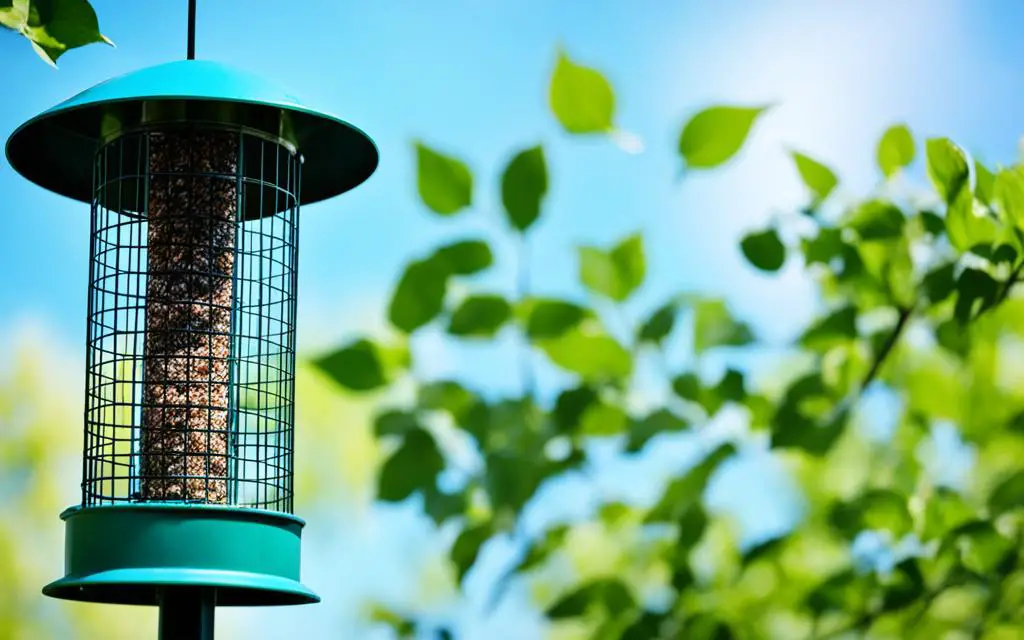
| Feature | Function | Benefit to Birds |
|---|---|---|
| Heavy-duty materials | Resist gnawing by squirrels | Leaves more food for birds |
| Weight-activated mechanisms | Close off access when squirrels attempt to feed | Prevents squirrels from depleting bird seed |
| Rust-resistant coatings | Mitigate corrosion over time | Lifetime reliability of feeder |
| Water-resistant seals and overhangs | Keeps interior dry against rain and snow | Maintain fresh and healthy seed supply |
| Drainage systems | Prevent water accumulation and spoilage | Reduces risk of disease and spoilage |
By emphasizing durability in both the feeder’s construction and its resistance to weather and pests, bird watchers can better serve the birds they love. The right choices in feeder materials and designs not only provide a dependable food source for birds but also contribute to a more balanced and secure backyard ecosystem.
Maintenance Matters: Bird Feeder Cleaning and Care
For the discerning bird enthusiast, keeping bird feeders in pristine condition is a swath of responsibility that ensures the vibrant parade of avian activity continues in one’s backyard. Responsible bird feeding is not solely about seed selection or feeder placement; it encompasses the conscientious practice of routinely cleaning bird feeders. This critical maintenance not only prevents the spread of diseases among birds but also prolongs the lifespan of the feeders themselves.
The Importance of Regular Cleaning
Knowledge on how to clean a bird feeder is as essential as knowing what to feed your feathered friends. Regular cleaning removes harmful bacteria and mold, which can spring from decaying seeds and bird droppings. A thorough cleaning routine should include emptying out old seeds and debris, washing with a diluted bleach or vinegar solution, and allowing the feeder to dry completely before refilling. A clean feeder is an inviting beacon for birds and a pillar of bird conservation efforts.
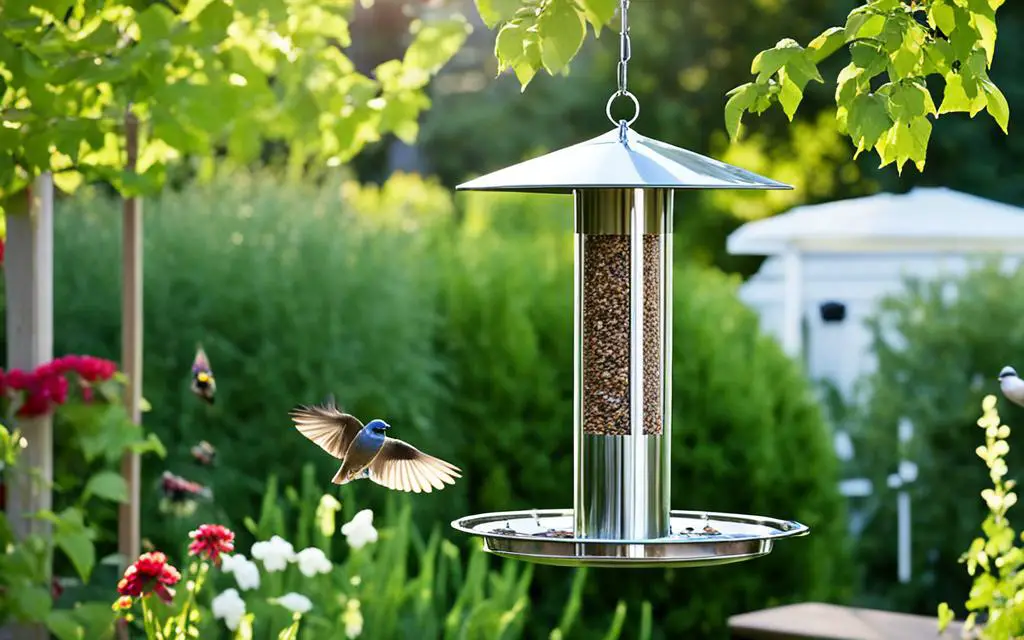
Easy-to-Clean Designs: A Must-Have for Busy Backyards
For bird lovers leading active lives, easy to clean bird feeders are a match made in heaven. Designs featuring removable trays and uncomplicated assemblies enable swift and thorough cleaning. A bird feeder with large capacity can mean fewer fill cycles, yet they should not compromise the necessity of frequent seed rotation to deter seed spoilage. Thoughtful feeder construction prioritizes simplicity in routine maintenance, ensuring a healthy environment for avian patrons and less hassle for the caretaker.
Dishwasher-Safe Feeders for Ultimate Convenience
The pinnacle of hassle-free maintenance is encapsulated in dishwasher-safe bird feeders. These marvels of ingenuity permit parts of the feeder to be placed in the dishwasher, ensuring a high degree of sanitation without the elbow grease. These designs not only save time but make the act of cleaning less of a chore and more of a seamless step in the bird feeding process. An easy to fill feeder, coupled with being dishwasher-safe, encapsulates the acme of convenient bird feeder maintenance.
| Feature | Importance | Benefits |
|---|---|---|
| Removable trays or components | Facilitates thorough cleaning | Minimizes the risk of disease |
| Large capacity | Reduces frequency of refills | Less maintenance and continued feeding |
| Easy to fill | Efficient refilling saves time | Encourages regular seed replenishment |
| Dishwasher-safe | Offers a high degree of sanitation | Streamlines cleaning process |
Decoding Bird Feeder Features: Perks That Make a Difference
When it comes to creating the ultimate backyard haven for birds, understanding the importance of advanced bird feeder features can elevate the bird feeding experience. Extra nuances like drainage holes are not mere design whims; they serve as critical components for maintaining seed dryness and hygiene. Similarly, the presence of a seed catcher tray considerably minimizes the ground waste, saving both time and seed.
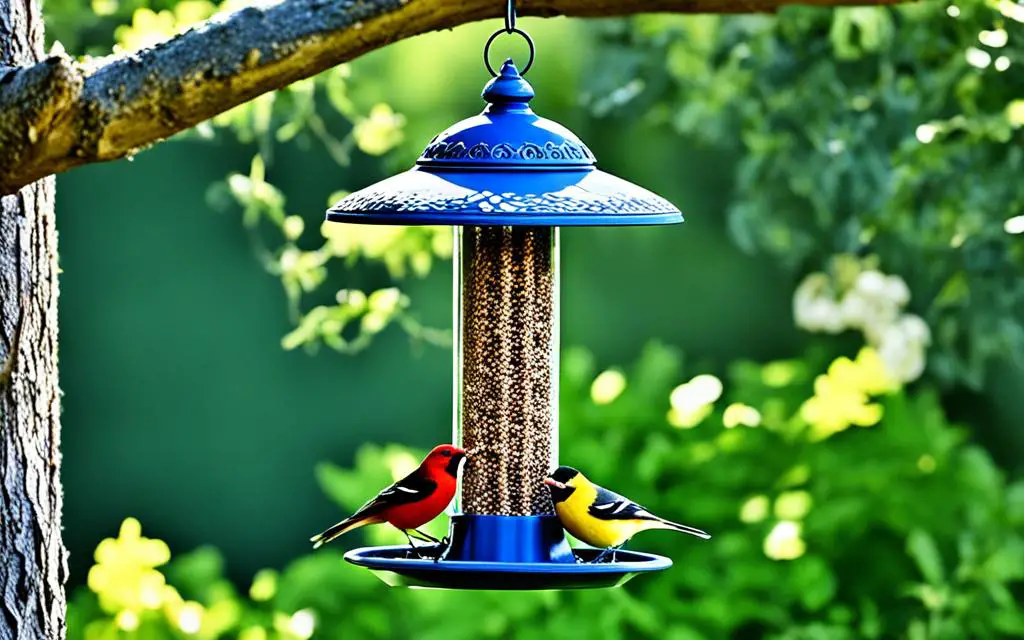
The incorporation of multiple feeding ports on a bird feeder does more than just cater to a crowd; it allows several birds to dine simultaneously, reducing competition and stress among the avian visitors. Meanwhile, strategically placed perches afford birds the comfort they need to relax and stay a while, encouraging more extended visits. For those with an eye for aesthetics, exploring options in solar powered bird feeders might offer a delightful blend of functionality and visual artistry, providing ambient lighting without disrupting the nocturnal serenity of your garden.
The allure of a decorative bird feeder resonates with both watchers and winged wonders alike, transforming functional bird feeding into an elegant backyard feature. Carefully chosen bird feeder accessories further individualize the birdwatching experience, augmenting the practicality and charm of your avian oasis.
| Feature | Function | Bird-Friendly Benefits |
|---|---|---|
| Drainage Holes | Allows water to escape | Keeps seeds dry, reducing mold and spoilage |
| Seed Catcher Tray | Collects dropped seeds | Lowers waste and ground mess |
| Multiple Feeding Ports | Accommodates more birds | Enables simultaneous feeding, reducing competition |
| Perches | Provide stable resting spots | Encourages longer visitations and comfort |
| Solar Powered | Utilizes solar energy for added features | Enhances nighttime beauty without disturbing wildlife |
| Decorative Design | Pleasing aesthetics | Attracts attention and complements garden decor |
In a nutshell, the thriving bird-friendly habitat you envision can be achieved by going beyond the basics and opting for bird feeders with these advantageous features. Whether you seek functionality, style, or a combination of both, the right attributes will ensure your feathered friends enjoy your offerings in a safe, clean, and inviting environment.
Protecting Our Feathered Friends: Safety Measures for Bird Feeders
Ensuring the welfare of birds is a significant aspect of bird feeding practices. With the right safety measures in place, bird enthusiasts can mitigate common bird feeder problems and make their backyards a sanctuary for these delicate creatures. Focusing on bird feeder safety and ways of keeping birds safe from predators are critical considerations.
Keeping Birds Safe from Window Collisions
Window collisions are a major concern for birds visiting backyard feeders. Positioning feeders appropriately can greatly reduce the risk of such impacts. Placement at a safe distance and the use of deterrents can minimize reflection and visibility issues, ensuring birds can feed without the danger of striking glass surfaces.
Designs That Discourage Predators
Protecting birds from natural predators is another vital component of feeder safety. Choosing designs that deter unwelcome guests and placing feeders in locations less accessible to predators can create a haven for birds. Barriers and shields are practical solutions that can be integrated into feeder designs for increased protection.
Feeders That Prevent Disease Spread Amongst Birds
Bird feeder safety encompasses measures that prevent disease spread amongst feathered visitors. Easy-clean feeders, those with built-in waste collection, and designs promoting dry seed storage are essential. Such features maintain a hygienic feeding environment, minimize spillage, and limit the transmission of diseases.
| Safety Feature | Description | Benefits to Birds |
|---|---|---|
| Strategic Placement | Placing feeders at distances that reduce the risk of window collisions | Prevents injuries and fatalities from impacts |
| Predator Deterrents | Incorporating guards or barriers to feeder design | Creates safe feeding zones, discouraging predator access |
| Hygiene-Promoting Design | Feeders that are easy to clean and protect seed from the elements | Reduces disease risk, ensuring bird health |
By considering the various aspects of bird feeder safety, bird lovers can greatly enhance the allure and security of their backyard feeders. Such considerations ensure that they are not only providing care for bird feeding but are also safeguarding their feathered friends from harm, promoting a happy and healthy garden ecosystem for everyone to enjoy.
Sustainability in Bird Feeding: The Role of Native Plants and Eco-Friendly Practices
Creating a wildlife habitat that supports backyard wildlife and contributes to nature’s balance requires more than just artificially supplying birdseed. To truly embrace sustainable bird feeding within your own slice of outdoor entertaining, it is imperative to integrate holistic approaches that mirror the intricate web of ecological interactions. Taking time to fashion a diy bird feeder can be part of an all-encompassing endeavor to foster a thriving haven for avian guests. Bridging the gap between human convenience and ecological integrity, these eco-friendly practices promise not only a lush spot for nature lovers but also a crucial stepping stone toward environmental stewardship.
Incorporating Native Flora to Supplement Feeding
Nature’s bounty is abundant and often untapped in our own backyards. By planting native flora, bird enthusiasts provide natural food sources and essential habitats for various bird species. These indigenous plants blend seamlessly with the local ecosystem, bolstering the integrity and resilience of area wildlife habitats without the need for extensive human intervention. Moreover, these native species often require less maintenance and water, reflecting sustainable gardening principles while tantalizing our feathered friends with their natural diets.
Eco-Friendly Material Choices for Bird Feeders
Environmental consciousness is a significant factor when selecting or crafting bird feeders. Materials that are sustainably sourced, such as reclaimed wood, bamboo, or recycled plastic, lessen our ecological footprint. Additionally, the durability of these materials means less frequent replacements, which in turn, reduces waste. Making a diy bird feeder from eco-friendly materials allows individuals to personalize their bird-feeding experience while affirming their commitment to sustainable bird feeding and living.
Encouraging Natural Foraging Behaviors
The charm of bird feeding lies not only in the joy it brings to us as observers but also in the role it plays in encouraging natural foraging behaviors among backyard wildlife. By strategically placing bird feeders in and amongst native gardens, birds are prompted to alternate between feeder visits and natural foraging. This dynamic reinforces birds’ innate behaviors, ensuring a balance in their activities and preventing over-dependence on supplementary food sources. Plus, it’s a spectacle of nature that adds a dynamic flair to any outdoor entertaining area, underlining the joy and responsibility attached to fostering a sustainable wildlife habitat.
Conclusion
Embarking on the enchanting journey of backyard birding with the aid of bird feeder selection help can transform your outdoor area into a vibrant wildlife habitat. Our exploration of diverse bird feeders has highlighted the benefits of bird feeding—from nurturing local avian communities to providing endless observation pleasure. In reviewing a multitude of feeder types and bird attractant strategies, it’s evident that the best bird feeder is one that balances the ecological interests of bird species with the practical needs of maintenance and safety.
Whether you’re motivated by the tranquil pastime of observing spirited chirps and feathers or by the goal of contributing to the conservation of bird diversity, your contributions to responsible bird feeding are invaluable. Accessible backyard bird feeder tips serve as helpful insights to guide you to make informed decisions. When considering where to buy bird feeders, it’s essential to seek out reputable retailers that offer durable and eco-friendly options, thereby continuing the cycle of sustainability.
In sum, the choices we make, from the selection of seeds to the feeder’s placement, echo a commitment to fostering a harmonious coexistence with our feathered friends. As bird enthusiasts, we can look forward to the infinite joys that come with each new visitor to our feeders, knowing that our efforts are a steadfast link in the chain of avian well-being and enjoyment.
FAQ
How do I choose the best bird feeder for my backyard?
What are the different types of bird feeders available?
What features should I look for in a squirrel-resistant bird feeder?
How important is it to have a weatherproof bird feeder?
How often should I clean my bird feeder?
What kind of seeds should I use to attract various bird species?
Where is the best place to install a bird feeder in my yard?
How can I keep birds safe from predators and window collisions?
What are the benefits of incorporating native plants into my bird feeding strategy?
Why should I consider eco-friendly materials for bird feeders?
Source Links
- https://www.humanesociety.org/resources/feeding-birds-your-backyard
- https://www.allaboutbirds.org/news/how-to-choose-the-right-kind-of-bird-feeder/
- https://www.homedepot.com/c/ab/best-bird-feeders-for-your-backyard/9ba683603be9fa5395fab901d58ac209

My name is Shane Warren, the author behind Your Bird Buddy – your ultimate guide to the wonderful world of birds! Unleash your inner avian explorer as we delve into a vibrant library of knowledge dedicated to all things feathered. From learning about diverse bird species from across the globe to understanding their captivating habitats and behaviors, I’m here to fuel your passion for these magnificent creatures. Not only that, but I also provide valuable insights on being a responsible and informed pet bird owner. Join our vibrant community and let’s celebrate the feathered wonders of the world together – one chirp at a time. And be sure to join our Your Bird Buddy Community over on Facebook!

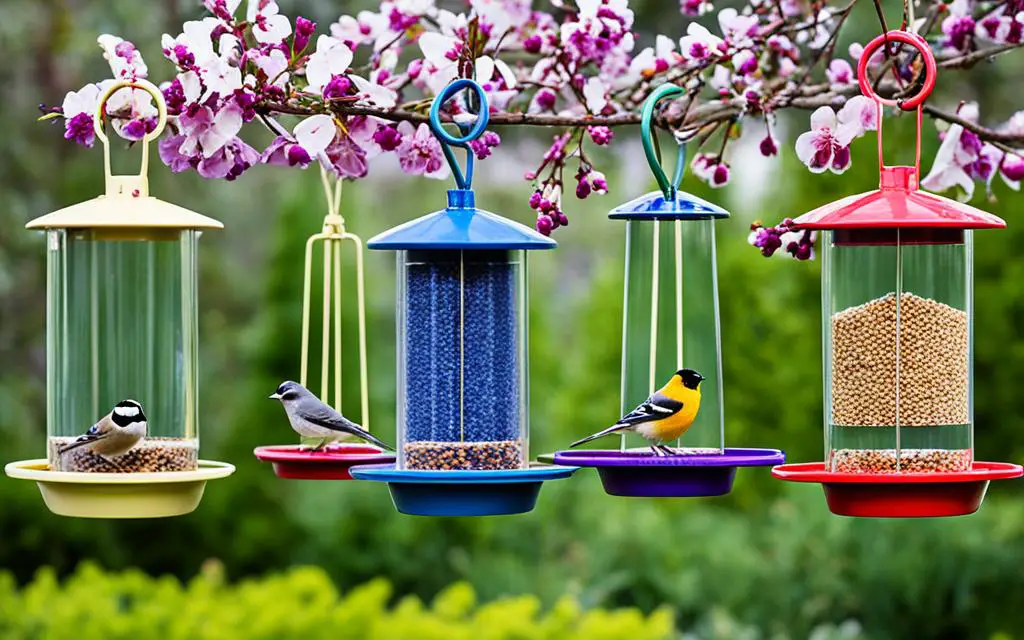
Comments are closed